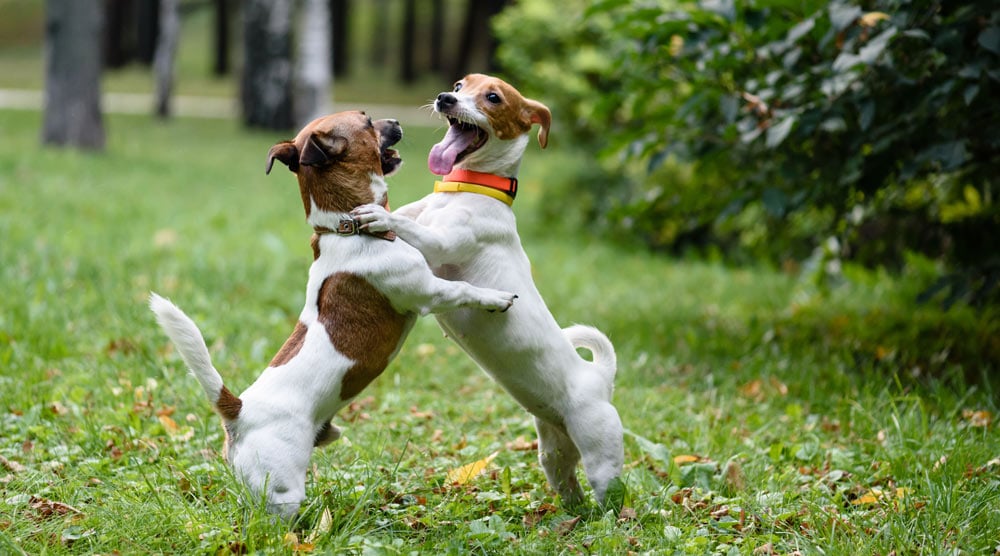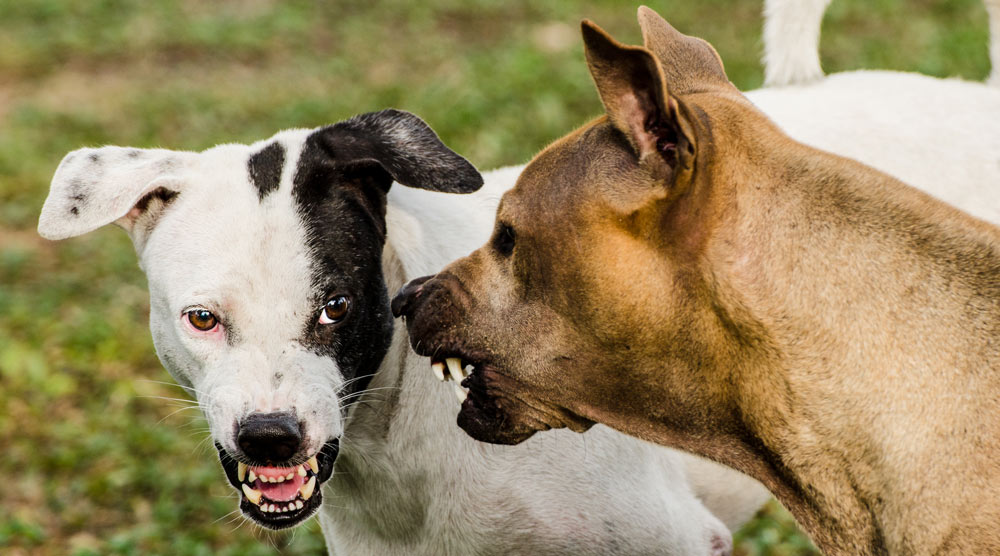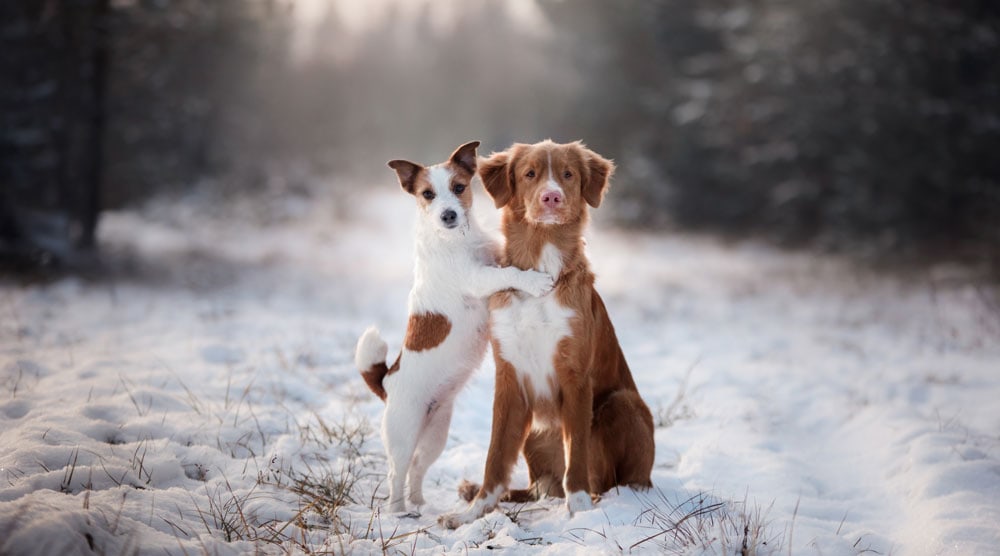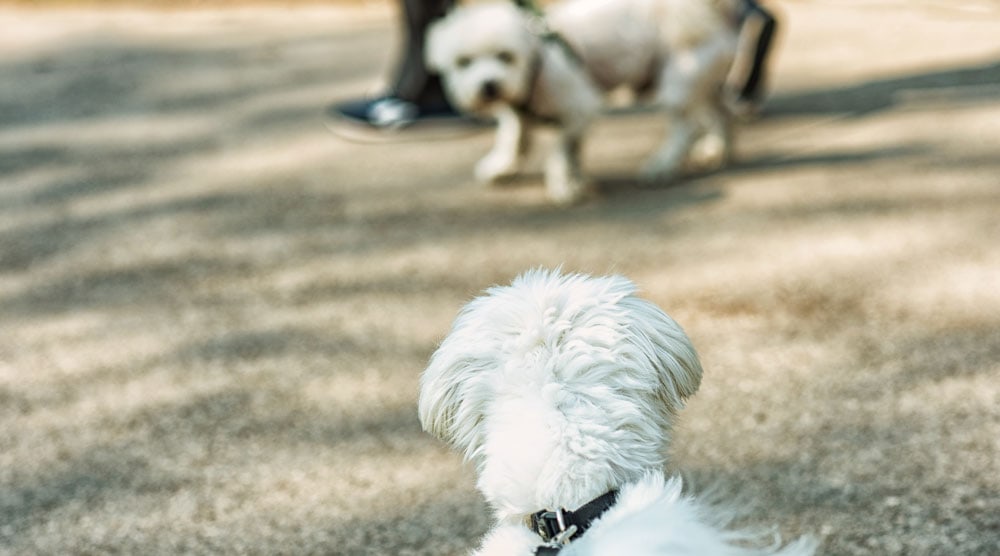We often get asked how to tell if dogs are playing or fighting. This might seem like a simple question – but canine play is a more complex topic than it first appears!
In fact, it can be surprisingly difficult to tell the difference between playing and fighting. Normal play often seems rough and loud, but isn’t real fighting. It can still be scary if you’re not sure what’s happening though.
To keep dog interactions safe, it’s important to understand canine body language signals. You should also monitor any play sessions and separate the dogs when play is becoming too rough.
Keep in mind that canine play is a very complicated topic. An interaction that looks rough might be play, while a game that starts relaxed can escalate into a serious fight. It’s also common for one dog to want to stop before the other, which can cause frustration and tension.
It’s impossible to cover every possibility in this article. Instead, we’ll go through some of the most common signs of both play and aggression.
Contents
Signs That Dogs Are Just Playing

There are many body language signals you can use to judge if dogs are playing, which we’ve listed below.
However, it’s important to understand that body language is contextual. There is often an overlap between signs of play and aggression, so you should watch your dog’s overall body language and behaviour, rather than relying on a single signal.
Another key point is that a dog might not be enjoying the interaction, even if they are not being aggressive.
For example, it’s common for one dog to overwhelm the other in a play session, rather than it being a balanced interaction. Or for one dog to keep trying to play when the other wants to stop.
In these situations, the dogs should be separated, even though they aren’t fighting. Aside from being unfair to the dog that isn’t enjoying itself, a one-sided interaction can escalate to a fight.
Play Bow
The “play bow” is one of the most common signs a dog wants to play.
When play bowing, the dog leans their chest to the floor and leaves their rear end in the air. Some dogs also slap their paws against the ground in an excitable way.
Relaxed and Exaggerated Movements
During play, a dog will often bounce around and move in an exaggerated way. This shows that the dog is in a playful mood.
Some dogs also jump around near the other dog to signal they want to play. While this is meant as an invitation to play, it can sometimes be overwhelming or stressful, depending on the other dog’s size and play style.
Exaggerated Vocalisations
Puppies often play growl when they are playing with their litter mates. Some dogs continue this behaviour as adults.
It can be scary to hear a dog growling during an interaction. But play growling is often higher pitched than the low, rumbling growl of a defensive dog.
Relaxed and Open Mouth
Dogs that want to play often have a relaxed and open mouth. This can sometimes make it seem like the dog is smiling.
However, this is only a sign of wanting to play if the mouth is relaxed. A tense open mouth could indicate stress or aggression.
Taking Turns
During a balanced and positive play session, the dogs should take turns. This often makes play look like a game of “tag”, as the dogs alternately take the role of the chaser.
Turn taking isn’t just important for chasing though. Whatever the dogs are doing, there should be a continuous back-and-forth. If only one dog is initiating each phase of play, it can cause the other to feel trapped, overwhelmed, and anxious.
Similarly, during a balanced interaction, play should always end if one dog stops playing. And if one dog is bigger or stronger than the other, it should show signs of holding back (sometimes called handicapping). This ensures that the play is safe and fun for both dogs.

What About Play Biting?
Play-biting is often part of a play session between two dogs. However, it can be difficult to tell the difference between true play biting, and nipping due to frustration or overstimulation.
If the mouth is relaxed and open, with minimal signs of the jaw closing around the skin (known as jaw sparring), it is likely to be play-biting. On the other hand, nipping or one-sided biting can signal frustration. Any yelping or signs of pain also shows that this isn’t play-biting.
As always, try to look at the dog’s overall body language. How is the biting being received by the other dog? And is it leading to more fun for both dogs? If not, it’s time to separate them.
Signs That Dogs Are Fighting (Or Are About To Fight)

The best way to prevent dog fights is to understand and identify aggressive body language signals. Some of these can seem similar to playing, but when combined with context and other signals show the dog isn’t happy about the situation.
Keep in mind that an aggressive dog is not a bad dog. Aggression is a normal behaviour in dogs, but it needs to be properly handled, so both dogs (and you) remain safe.
Stiff Body Language
A tense posture is a common sign that a dog is preparing for aggression. There won’t be any play bowing, bouncing, or relaxed body positions.
Some signs of stiff body language to watch out for include:
- Ears pinned back
- Frozen body position
- Stiff tail
- Raised hackles (hairs along the spine)
Low Growling and Snarling
Dogs often give an exaggerated growl when playing, but this differs from the low warning growl associated with aggression.
During a warning growl, the lips are usually pulled back into a snarl. The mouth will be tense, unlike the relaxed “grin” that can signal play.
Fast or Sudden Lunging
Stiff body language, growling, and snarling are all warning signs of a potential fight. But when a real fight starts, it’s often sudden and involves a violent lunge towards the other dog.
There won’t be any of the handicapping or playful back-and-forths that are seen when two dogs play.
Chasing a Dog That Isn’t Playing
Sometimes an aggressive interaction won’t turn into a fight. Instead, one dog may continuously chase the other.
This chasing behaviour is sometimes mistaken for play. Look for signs that the chased dog isn’t enjoying the interaction, such as a tucked tail and lack of exaggerated movements.
Biting
We mentioned earlier that dogs might pretend to bite during play, but aggressive biting is much harder and can cause puncture wounds. The other dog may whimper or yelp, showing that they are in real pain.
Sometimes a biting dog may not let go during a fight. This can be a very dangerous situation, which is why preventing dog fights is vital.
What Should You Do If Your Dog Is Fighting?
Many dog fights could be avoided by removing a stressed or aggressive dog from the situation before it can escalate.
Pay close attention to your dog’s body language. Are they showing any warning signs, such as a stiff posture, low growling, snarling, or a stiff tail? These are all signals that a fight could be imminent.
It’s also important to know your dog, and how they are likely to react, so you can avoid putting them in uncomfortable situations.
For example, if your dog is often aggressive towards other dogs, keep them on a leash when walking. Try to walk them at locations where you can see other dogs at a distance and avoid them.
If a fight has already started, it’s important not to panic. Many dog fights are short and don’t cause injury. Here are some tips for how to react:
- Try to remain calm, as additional stress or excitement could make the situation worse.
- Do not try to pull the dogs apart. One of the dogs will likely bite.
- If the dogs naturally separate and it is safe to do so, calmly remove your dog from the situation.
- Loud noises can distract dogs during a fight. A car horn or clapping are two useful examples.
- If the fight is continuing, find an object to separate the dogs. A chair, umbrella, or big stick can all work.
- If the fight is indoors, use a baby gate or flat-packed cardboard box to separate the dogs.
While dog fights are often quick, they can cause severe injury depending on the dogs involved. If your dog is injured, even with a small wound, then take them to a vet immediately. There may be internal injuries that aren’t visible.
Why Do Dogs Play Fight?
Puppies naturally play fight. It’s an important part of their social development, as play fighting teaches how to safely play, how to communicate, and how to control their impulses.
This behaviour continues in some dogs as they get older. However, not all dogs enjoy playing with other dogs, so it’s important to know your dog’s personality and step in when required.
Should You Let Your Dogs Play Fight?
Play fighting can be a normal and safe activity for two well-socialised dogs that enjoy this style of play, but it’s not always a good idea.
For example, it’s common for play to escalate into actual fighting if one dog becomes too boisterous, or if the play continues too long. You should monitor the dogs at all times and separate them if there are any signs of stress or frustration. These include:
- Panting
- Lip licking
- Trying to move away or disengage
- Whining or other vocalisations
- Increasingly frantic interactions
- Not taking turns
- “Telling off” the other dog
Additionally, not all dogs understand canine “manners” and body language. If a dog doesn’t want to play, then it’s vital that the other dog respects (and understands) the other’s communication.
For this reason, look for signs of play in both dogs. It’s not unusual for one dog to think they are playing, while the other is uncomfortable, stressed, and wanting to move away.
Another issue is play fighting between more than two dogs. Adding more dogs to the situation makes it much more likely to escalate into a fight, so it’s best to avoid this. You should also avoid letting dogs play when there are food, chews, or toys nearby, as this can lead to possessive behaviour.
Tip: Even if your dog enjoys play fighting, it’s a good idea to only allow it to happen occasionally. The more they practice this behaviour, the more they’ll want to do it, which can cause problems if your pet expects to play with every dog they see on a walk.
What Are The Signs That Play is Becoming Too Rough?
Even if two dogs are not showing signs of aggression, it’s still possible that one of them isn’t enjoying the interaction. Dogs all have different play styles and stress thresholds, so it’s important that the interaction is balanced and fun for both.
Watch out for signs that one of the dogs isn’t enjoying what’s happening. If the play starts to become frantic, involves more play biting, or if one of the dogs is not engaging in the same way as the other, then it’s important to separate them.
In a group situation, never allow a single dog to be ganged up on by the others. This can be a traumatic and dangerous experience that may lead to future dog anxiety.
You should also be careful that smaller dogs are not overwhelmed by bigger dogs. The dog should be able to move away and disengage. If the other dog keeps restarting the play, then the dogs should be separated.
Tip: Don’t rely on tail wagging to judge whether a dog is happy! A wagging tail can mean different things depending on the situation. For example, a stiff tail wag can indicate stress or aggression.
What About Puppies Playing With Adult Dogs?
Contrary to what many dog owners think, it is not the responsibility of adult dogs to teach a puppy canine manners!
Most adult dogs don’t enjoy vigorous play like puppies. Many puppies also haven’t yet learned to understand other dogs’ signals that they don’t want to play.
For these reasons, keep play sessions between puppies and adults short. Impose regular breaks, so the puppy doesn’t get carried away, and the adult dog gets space. End the play session if either dog shows signs of stress or frustration.
Summary
It can be fun to watch two dogs play. However, it’s vital that both dogs enjoy the interaction, and that you’re aware of potential signs of aggression.
Body language signals indicating aggression include a stiff posture, snarling, and low growling. Fighting often involves one of the dogs suddenly lunging towards the other, chasing without taking turns, or biting with force.
Do you have any questions about how to tell if dogs are playing or fighting? Please let us know in the comments section below.


